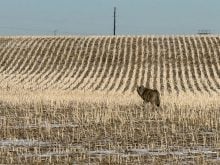Canadian hog farmers should plan for the worst, but keep recent predictions about free falling North American hog prices in perspective, according to a market analyst.
“Nobody knows the U.S. pork industry like Glenn Grimes,” said Kevin Grier, who writes the Canadian Pork Market Review from the George Morris Centre in Guelph, Ont.
“But take it for what it’s worth: He’s sending out a red flag.”
Producers should realize “there’s a high probability that prices will be stagnant to lower on average for the next two years,” said Grier.
Read Also

Agritechnica Day 2: The future of tractor power, building quicker crop apps and large farms and tech
Agritechnica Day 2: The future of tractor power, building quicker crop apps with Syngenta and large farms and tech
Martin Rice, of the Canadian Pork Council, said he agrees, especially if Asian markets don’t rebound.
“We really should be prepared for some difficult times, and lasting longer than we would like to see,” Rice said.
Canadian producers are relatively small players in the North American hog market. American prices are the main component in Canadian prices.
But there are two other parts to Canadian prices, said Grier.
When the Canadian dollar slips, hog prices go up. This has been a blessing so far in a year with poor hog prices. But Grier said the currency exchange probably has more risk of rising now than dropping further, which will be negative for hog prices.
The silver lining for prairie producers is growing slaughter capacity, with packers expanding in Alberta and Manitoba.
During the next three years, the spread between western Canadian prices and U.S. Midwest prices will likely narrow, said Grier.
“You’re going to have a lot of packers running around with their tongues hanging out, looking for hogs, and that’s only going to be positive for the spread.”
Kelly Zering, an economist from North Carolina State University, agreed the increase in slaughter capacity in Canada will be a big bonus for producers.
“It may be the difference between breaking even and making a profit over the next few years,” said Zering, who is originally from Winnipeg.
Chris Hurt, economist at Purdue University, said the worst of the hit will come this winter, with American prices in the low $30s per live hundredweight.
They’ve already dropped below $40 (U.S.) per cwt. in July. This time last year, average prices were in the high $50s per cwt.
Leland Southerd, economist with the U.S. Department of Agriculture, said it’s easier to live with falling prices if costs are lower.
Feed prices may also be low, if record large crops come off with few hitches. Corn and soybean crops will also have to be giant in 1999, he noted.
“Although the returns will not be great, it will not be the disaster that it implies,” said Southerd.
Hurt said he thinks production will be cut back enough by late 1999 for farmers to start breathing easier.
“It’s probably around the turn of the century and millenium that we should begin to get a much improved situation for pork producers.”














